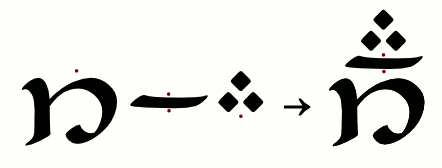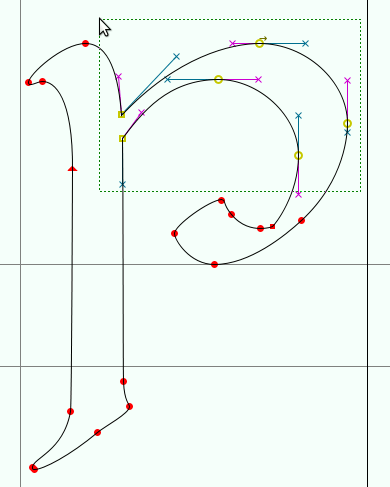There are still a lot left to do design-wise when it comes to Tengwar Telcontar: for example, all the tengwar should ideally have a corresponding larger, ornated variant, but there are still some missing, notably rómen and silme. The s-hook, or sa-rince, should ideally be able to attach to any tengwa, but there are still some that lack this combining ability. Today, I drew a sa-rince for rómen, and if I may say it myself I’m pleased with the result:
(That is supposed to be the Latin word ars (‘art’), by the way. Now that I write this I suppose that you could read it as if it were English, but that was not my intent.) Anyhow, correct me if I’m wrong, but I don’t think this particular combination is possible to write with any previous fonts, though it is in fact attested in Tolkien’s hand, in DTS 25. That specimen also exhibits an interesting lambe-lambe ligature. Hm…
However, the next thing I’m going to work on, probably, is a rather major change, but which takes place behind the scene: when finished, the resulting font will barely be noticably different from the current version. The change concerns the method to position the tehtar. Today, tehta positioning is achieved by means of anchor points: each glyph has a number of anchor points defined, and then the glyphs are attached to each other in such a way that the anchor points overlap:
While this is a fairly elegant and powerful technique, it also has its drawbacks once we need more precision in the positioning. It is difficult to place the anchor points in such a way that all the tehtar combine nicely with all the tengwar. In the example below, the tehtar and the tengwa óre all have their anchor points in the logical places, visually centered horizontally.
Now, where should the anchor point be placed on silme? We can align the i-tehta in a visually pleasing way, and then it will define silme’s anchor point. But, what happens if we then try to use that point to also attach the a-tehta? It won’t work very well: wider tehtar should ideally be adjusted to not collide with tengwar with ascenders. To deal with issues such as this, one could use more anchor points, introduce kerning after the positioning, use alternative glyphs, etc. Needless to say, things easily get very complicated.
That is one reason, but the main reason why I’m moving away from anchor points is that they are difficult to implement with AAT, Apple’s smart font technology, and I would very much want to have Tengwar Telcontar work on the Mac. So, instead of anchor points, I will rely solely on contextual glyph substitution: exactly as how tehtar are positioned in Dan Smith’s fonts, there will be a number of glyphs for each tehta, each with varying displacement, but unlike Dan Smith’s fonts, the correct glyph will be chosen automatically, and, for me as a designer, there is no specific restriction on how many different glyphs I may use — I foresee that I may use as many as ten or more for each tehta, to get exactly the positioning I want on each tengwa.
In short, I will have to rewrite a large part of the code, but the end user will probably not notice the difference. Unless they use a Mac, that is.






